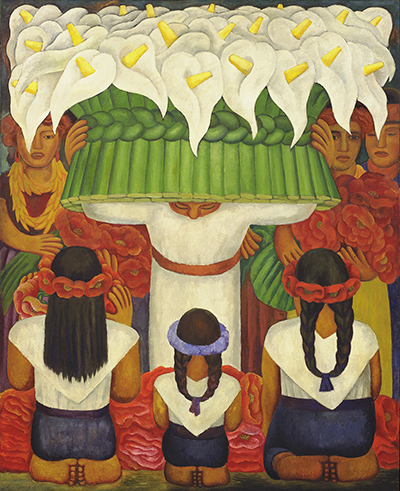Diego Rivera produced Flower Festival: Feast of Santa Anita in 1931. It is one of a number of paintings from his career which concentrate on important themes found in the lives of Mexicans, such as strong community and celebration.
The artist was always in touch with the poorer elements of society and found more of a connection with ordinary Mexicans than he did with anyone else, even after achieving considerable fame for his work. In this example we find a strong woman carrying an abundance of flower heads on her back, whilst other members of the community look on. Some stand besides her, helping to carry the burden, whilst the younger ones look on in excitement during this celebratory event. Colours are key here, with bright tones found throughout life in Mexico, and most artists would carry that over into their paintings. Rivera would also sometimes place different generations together within the same compositions which was another way of representing society, rather than just the individuals involved. One can see the same with Klimt's Three Ages of Woman, for example, even though the artistic styles were fairly different.
The painting was set in a flower festival on Good Friday in Santa Anita. The artwork was exhibited almost immediately alongside a number of other items from Rivera's career at MoMA. Personal exhibitions were particularly rare at that time, for a number of reasons, and so it was quite an honour for Rivera to be featured in this way, particularly as someone whose roots were from neither the US nor Europe. It underlines the success that he was starting to enjoy by this decade and how he had now become very much an international celebrity rather than just a major domestic figure within his native Mexico. In previous years he had been travelling much of the time because of political instability within the country of his birth, forcing him to build his reputation elsewhere which would ultimately prove to be of great benefit to his overall legacy.
This painting can today be found in the collection of MoMA, which remains one of the most important contemporary art galleries in the world. They have close to one hundred artworks from his career alone, along with a wealth of art from other major figures from across the US and Europe too. Young Man in Gray is amongst the other memorable Rivera paintings within their collection but most of the other items are ink and watercolour pieces from around the 1920s which presumably were gifted to the institution together in bulk by one particularly active collector some years ago. MoMA themselves list Flower Festival Feast of Santa Anita as being 199.3cm x 162.5cm in size and completed using encaustic (combining wax and pigment) on canvas. Rivera liked to try out different mediums for painting and could never stick solely to the more popular oils for long before looking to try out alternatives once more. It may have been that this painting was actually loaned to MoMA, rather than being part of its permanent display.
Flower Festival Paintings by Diego Rivera
The artist loved this theme for his work, seeing it as an ideal opportunity to deliver bright colour, nature and scenes of everyday life into his work. It suited his style perfectly and also he felt a great interest in the lives of ordinary Mexicans. He would therefore re-visit the topic many times, with other examples including the likes of Flower Festival, Vendedora de Flores (Flower Vendor), The Flower Carrier and Nude with Calla Lilies as well as Flower Festival: Feast of Santa Anita, as found here. He would also use flowers in many other ways within his paintings, such as to decorate hte interiors of rooms in which he created portraits, or alternatively with local workers collecting and carrying them around in their local communities.




